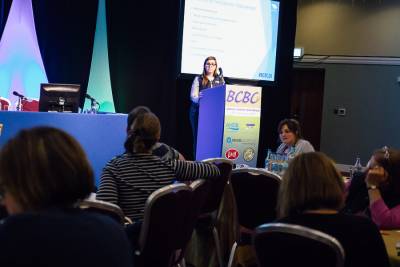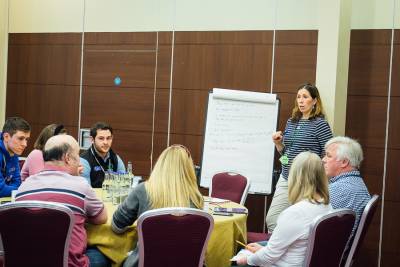

Based on feedback from previous conferences, the British Cattle Breeders Club committee decided to try a new format for the Monday afternoon beef workshop. We decided to go back to basics and run a more interactive style of workshop for farmers that wanted help to develop a breeding plan. The workshop was run by staff from AHDB Beef and Lamb, with some assistance from BCBC committee members.
The afternoon started with a back to basics talk on what estimated breeding values are, how they are calculated, and how to interpret them to help make breeding decisions on farm. The audience was very engaged, and some interesting questions and discussion followed.
The audience was a varied one, containing not only beef farmers, but students, researchers and industry representatives. Instead of trying a one size fits all approach, we decided to offer two sessions for the second part of the afternoon. The first of these was a practical session for farmers and students, with the second being for industry.
The farmer breakout session started with a discussion on the factors that make a profitable beef enterprise. Delegates were split into groups and discussed 3 areas of a beef enterprise, the maternal environment, the post-weaning growth environment, and the slaughter/market environment. Each group brainstormed what was necessary in each of these areas for a beef enterprise to be profitable, how these features could be measured, and whether there were EBVs available for farmers to improve these features through genetics. In many cases the answer was yes. The groups were then each given a farmer scenario detailing a particular farming enterprise where a new bull was required, along with a large number of bull EBV charts. Each group was asked to evaluate what the farmer needed to improve in each situation, and choose an appropriate bull for their system. After some vibrant discussion, all groups were able to make choices that they were happy with.
Although EBVs are an important element when choosing bulls for breeding, they should not be the only consideration. In the farmer breakout session we therefore invited Rob Hall from LLM vets to take part, who gave a comprehensive overview of the need for physical soundness in a working bull, and the ins and outs of a breeding soundness exam. As in the rest of the session, delegates were very engaged and generated some good discussion on this, particularly regarding the use of electro-ejaculation techniques.
Industry attendees attended a separate breakout session to look at the barriers to producers embracing developments within the area of genetic improvement on farm, particular in terms of breeding plans. Three groups considered three separate scenarios and focussed on what was holding development back and what would encourage uptake. There was particular focus on what BCBC could do to have a positive impact on this and numerous ideas were floated. There was plenty of enthusiasm but only time will tell if BCBC is able to make a significant positive impact in this area.
Overall, the feedback from delegates on the new format was overwhelmingly positive, and we hope to continue to host the Monday beef workshop with a more interactive element going forward. As is the case for the whole conference, we strive to provide content which is of direct interest to beef farmers. We would therefore welcome your thoughts on themes that you would like to see covered at future beef workshops. To share your thoughts, please contact heidi.bradbury@cattlebreeders.org.uk